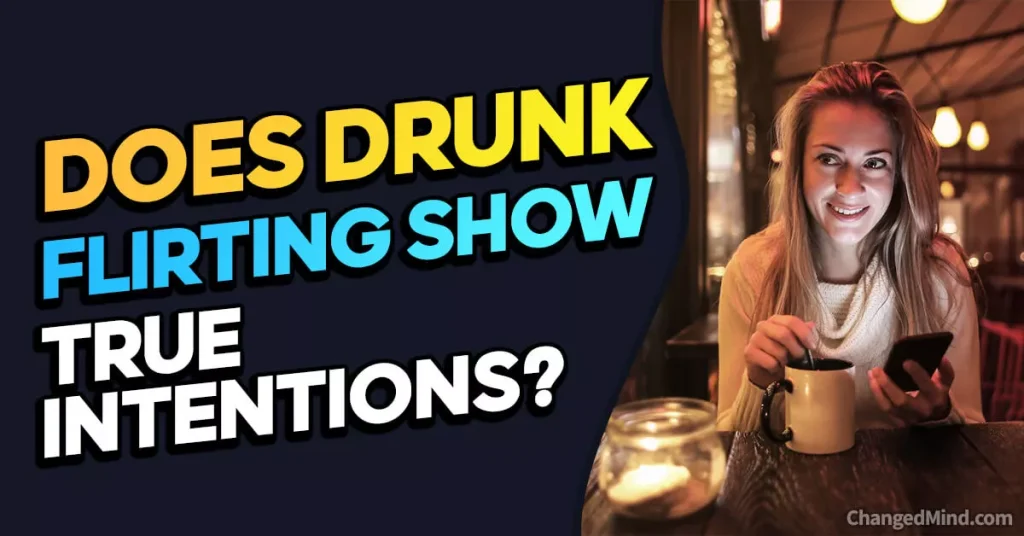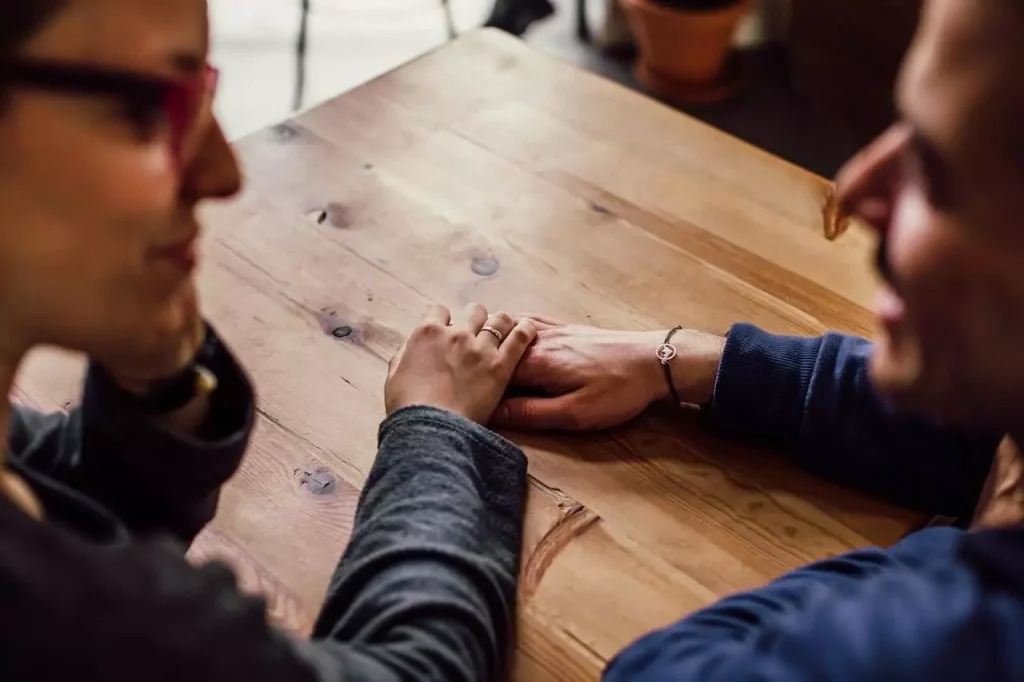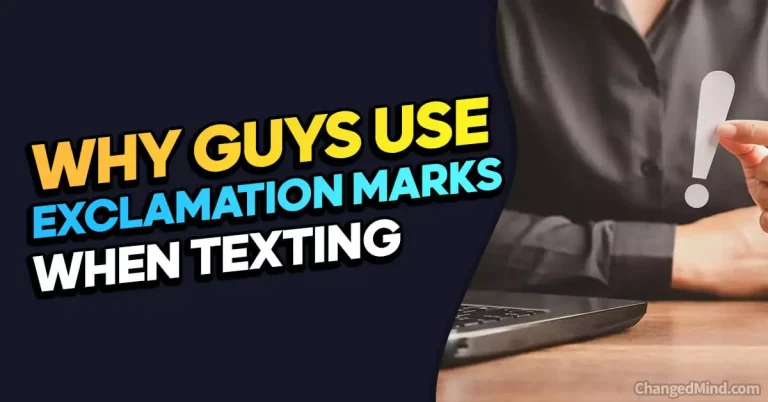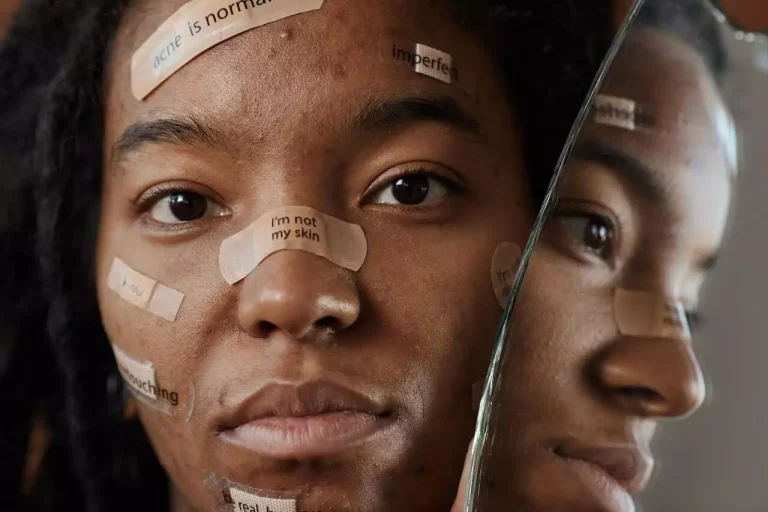Have you ever found yourself in the midst of a lively social gathering, with the atmosphere buzzing and laughter filling the air, when suddenly, you notice someone engaging in some rather flirtatious behavior under the influence of alcohol? It’s a common scene, right? But the question that often lingers in the back of our minds is, “Does drunk flirting show true intentions?” 🍸💬
Well, you’re in the right place because we’re about to dive deep into this intriguing topic. From deciphering the blurred lines between genuine interest and alcohol-induced antics to understanding the impact of those flirty gestures, we’ve got you covered. 🕵️♂️🧐
As experts in human behavior and relationships, we’ll explore the twenty signs that might just reveal whether those tipsy flirtations are a true reflection of someone’s feelings or merely a consequence of the spirits. So, grab your favorite beverage (perhaps not the alcoholic one just yet!), and let’s uncover the secrets behind the question, “Does drunk flirting show true intentions?” 🚀🤓
Key Points to Explore:
- The influence of alcohol on behavior
- Signs of genuine interest vs. drunken advances
- Communication and consent in flirtatious encounters
- Avoiding misunderstandings in drunk flirting situations
- The role of clear intentions and boundaries in relationships
Explaining Drunk Flirting
Drunk flirting refers to the act of engaging in playful or romantic behavior while under the influence of alcohol. It often involves increased socialization, heightened confidence, and a relaxed state of mind. In these situations, individuals may express attraction, compliment others, or engage in flirtatious banter that they might not have the courage to do when sober.
The Controversy Surrounding Drunk Flirting
Drunk flirting is a topic that stirs up debates and differing opinions. On one hand, some argue that alcohol acts as a truth serum, revealing one’s true intentions and feelings. According to this perspective, people feel more comfortable expressing their desires or attractions when they are under the influence.
On the other hand, skeptics believe that drunk flirting is nothing more than a fleeting moment of infatuation or an exaggerated display of emotions due to alcohol’s influence on inhibitions and decision-making abilities. They argue that these actions may not truly reflect a person’s sober thoughts or intentions.
The implications of drunk flirting can be significant, as it can lead to misinterpretations, mixed signals, and potential misunderstandings in both casual encounters and established relationships. So, let’s dive deeper into the world of drunk flirting and explore whether it uncovers true intentions or simply represents temporary feelings.
Remember to check out the rest of this blog post, where we’ll delve into the effects of alcohol on behavior, the psychology of flirting, and the impact of drunk flirting on relationships. We’ll also provide practical tips for navigating this complex terrain. Stay tuned!
20 Signs That Make You Understand if the drunk person means what they say
| Signs of Drunk Flirting Showing True Intentions | Meanings from Your Perspective |
|---|---|
| Consistency in behavior when sober | It suggests that their feelings and actions align whether sober or drunk. |
| Genuine interest in getting to know you | They show curiosity about your life and personality beyond the surface. |
| Respectful and non-invasive flirting | Their flirtatious gestures are considerate, never crossing boundaries. |
| Remembering details about you | They recall information about you even after drinking. |
| Prioritizing your comfort and boundaries | They respect your limits and ensure you feel safe. |
| Meaningful conversations amidst the party noise | Their interest in engaging conversation shines through even when drunk. |
| Treating you with kindness and respect | They exhibit polite and respectful behavior, regardless of alcohol. |
| Listening to your thoughts and opinions | They value your viewpoints and actively engage in discussions. |
| Making an effort to spend time with you | They seek your company and prioritize spending time together. |
| Avoiding excessive alcohol consumption | They moderate their drinking to remain in control of their actions. |
| Maintaining eye contact and body language cues | Their non-verbal signals convey genuine attraction and interest. |
| Consistently showing affection | They express physical affection, reinforcing their feelings. |
| Supporting your goals and aspirations | They encourage your dreams and cheer for your successes. |
| Offering help and assistance when needed | They provide assistance and support, even in social settings. |
| Demonstrating patience and understanding | They remain patient and understanding, even when alcohol is involved. |
| Including you in future plans and activities | They envision a future together and include you in their plans. |
| Expressing emotions beyond alcohol-fueled courage | Their emotional openness extends beyond drunken courage. |
| Communicating openly about their feelings | They are willing to discuss their emotions and intentions with you. |
| Maintaining consistent contact after the event | They stay in touch and continue to show interest post-event. |
| Demonstrating genuine concern for your well-being | They prioritize your happiness and well-being over everything else. |
These signs can help you gauge whether drunk flirting may indeed reveal someone’s true intentions.

Here are 15 signs that can help you understand if a drunk person means what they say:
- Consistency: If their words align with their behavior and attitudes when they are sober.
- Sincerity: They express their thoughts and feelings with genuine emotion and conviction.
- Contextual relevance: Their statements are relevant to the current conversation or situation.
- Clarity of speech: Despite being intoxicated, they can articulate their thoughts clearly without slurring or stumbling over words.
- Eye contact: They maintain steady eye contact, indicating engagement and sincerity in their communication.
- Body language: Their body language, such as open posture and attentive gestures, reflects their genuine interest and involvement in the conversation.
- Focused attention: They actively listen and respond thoughtfully, showing that they are present and engaged in the interaction.
- Specificity: They provide details, examples, or anecdotes to support their statements, indicating thoughtfulness and authenticity.
- Emotional congruence: Their emotions align with their words, demonstrating a genuine connection between what they express and how they feel.
- Empathy and understanding: They show genuine concern and empathy towards others, demonstrating emotional intelligence and a genuine desire to connect.
- Recollection: They remember and reference previous conversations or events accurately, indicating an authentic investment in the relationship.
- Follow-through: They demonstrate a willingness to act on their words and commitments, even when sober, displaying consistency and reliability.
- Personal vulnerability: They open up about personal experiences or emotions, showing trust and a genuine desire to connect on a deeper level.
- Appreciation and gratitude: They express sincere appreciation and gratitude for the people and experiences in their life, showcasing positivity and sincerity.
- Respectful communication: They communicate respectfully, without crossing boundaries or exhibiting inappropriate behavior, indicating a genuine intention to foster healthy connections.
It’s important to remember that while these signs can provide insights, the impact of alcohol on judgment and inhibitions should be considered. Always exercise caution and use your best judgment when interpreting someone’s words and intentions, especially in alcohol-fueled situations.

10 Ways of How to respond to drunk flirtation
Here are 10 ways to respond to drunk flirtation:
- Stay calm and composed: Maintain your composure and avoid overreacting to the drunk person’s advances.
- Assess the situation: Consider the context, your own feelings, and the level of sobriety of both parties involved.
- Set boundaries: Politely and firmly establish your personal boundaries to ensure your comfort and safety.
- Redirect the conversation: Shift the focus of the conversation to neutral topics to steer away from flirtatious behavior.
- Use humor: Light-hearted humor can help diffuse tension and deflect unwanted advances without causing offense.
- Be direct and assertive: Clearly communicate your lack of interest or willingness to engage in flirtation, using assertive yet respectful language.
- Enlist the help of friends: If the situation becomes uncomfortable, seek support from friends or acquaintances who can assist in redirecting or diffusing the flirtation.
- Offer a polite decline: Express your appreciation for the attention but kindly decline any further advances, emphasizing your desire to maintain a platonic or professional relationship.
- Exit the situation gracefully: If the flirtation persists despite your responses, remove yourself from the environment to prioritize your comfort and well-being.
- Practice open communication: Engage in open and honest communication, expressing your boundaries and expectations to avoid misunderstandings in the future.
Remember, every situation is unique, and it’s essential to trust your instincts and prioritize your own well-being when responding to drunk flirtation. Respectful communication and setting clear boundaries can help navigate these encounters while maintaining healthy relationships.

Understanding Alcohol’s Effects on Behavior
When it comes to drunk flirting, it’s crucial to understand the impact alcohol has on our cognitive and emotional processes. Let’s take a closer look at how alcohol affects our behavior in social situations.
How Alcohol Affects Cognitive and Emotional Processes
Alcohol is a central nervous system depressant that affects the brain’s functioning. It influences various cognitive functions, including judgment, perception, and self-control. Here’s how alcohol’s influence on these processes can shape our behavior during flirting encounters:
- Impaired Judgment: Alcohol can impair our ability to make sound decisions and evaluate situations objectively. It diminishes our capacity to consider the consequences of our actions, leading us to act on impulses without considering the long-term implications.
- Altered Perception: Alcohol can distort our perception of reality, including how we interpret social cues, body language, and verbal communication. This altered perception can impact our ability to accurately understand others’ intentions or convey our own effectively.
- Diminished Inhibitions: One of the well-known effects of alcohol is the reduction of inhibitions. As our inhibitions decrease, we may feel more comfortable taking risks or expressing ourselves in ways we might avoid when sober. This can contribute to the willingness to engage in flirtatious behavior that we might not typically exhibit.

Impact of Alcohol on Inhibitions and Decision-Making Abilities
Have you ever heard of the term “liquid courage”? Well, it turns out there’s some truth to it. Alcohol’s influence on inhibitions and decision-making abilities can contribute to the behavior observed during drunk flirting:
- Lowered Inhibitions: Alcohol lowers our inhibitions by suppressing the brain’s frontal lobe, which is responsible for impulse control and decision-making. As a result, we may feel more liberated to express our desires, compliments, or attraction without the usual self-consciousness or fear of rejection.
- Heightened Risk-Taking: Alcohol’s impact on decision-making abilities can lead to an increased willingness to take risks. This can manifest as making bold moves or engaging in flirtatious behavior that we might consider too risky or forward when sober.
- Reduced Self-Awareness: Alcohol’s effects can also reduce self-awareness, making us less attuned to how our actions may be perceived by others. This lack of self-awareness can contribute to behaviors that might be seen as inappropriate or overly flirtatious.
Connection between Alcohol and Enhanced Socialization
Alcohol has long been associated with socializing and creating connections. It can have both positive and negative effects on social interactions, which are relevant when considering drunk flirting:
- Increased Sociability: Alcohol can enhance our socializing abilities by reducing social anxiety and boosting confidence. This can make us more approachable and open to engaging in flirtatious interactions.
- False Sense of Connection: While alcohol can facilitate initial connections, it’s important to recognize that the sense of connection experienced during drunk flirting may not always translate into genuine, lasting relationships. The influence of alcohol can create an artificial bond that may dissipate once sobriety returns.
Understanding the effects of alcohol on behavior is essential when examining the intentions and feelings expressed during drunk flirting. It’s a complex interplay of altered judgment, diminished inhibitions, and enhanced socialization.
In the next sections, we’ll explore the psychology of flirting and delve deeper into the authenticity of intentions expressed during drunk flirting. Stay tuned!

The Psychology of Flirting
Flirting is a fascinating aspect of human interaction that encompasses various motives, behaviors, and underlying psychological factors. To understand the implications of drunk flirting, it’s essential to explore the psychology behind this captivating phenomenon.
Defining Flirting and Its Significance in Human Interactions
Flirting can be defined as a social behavior that communicates romantic or sexual interest in a playful and non-serious manner. It serves as a way to initiate connections, express attraction, and establish rapport between individuals. Flirting can occur in various settings, such as social gatherings, parties, or even online platforms.
Flirting plays a significant role in human interactions as it serves several purposes, including:
- Attraction and Courtship: Flirting is often the initial step in the process of courtship and romantic attraction. It allows individuals to express interest and create a sense of intrigue.
- Building Connection: Flirting helps establish a connection and rapport between individuals. It can create a comfortable and lighthearted atmosphere that fosters further interaction.
- Boosting Self-Esteem: Engaging in flirtatious behavior can boost self-confidence and provide validation. It allows individuals to feel desirable and attractive.
- Social Bonding: Flirting can also serve as a means of bonding within social groups. It helps strengthen relationships and create a sense of camaraderie.

Exploring the Motives and Underlying Psychology Behind Flirting
Flirting is driven by a multitude of motives and psychological factors. Some of the common motives behind flirting include:
- Sexual Interest: Flirting can stem from a genuine sexual attraction or desire for physical intimacy.
- Validation and Ego Boost: Individuals may engage in flirtatious behavior to seek validation, boost their self-esteem, or feel desired by others.
- Playfulness and Fun: Flirting can be motivated by a desire for fun and enjoyment, without necessarily intending for it to lead to a serious romantic connection.
- Establishing Power and Dominance: In some cases, individuals may use flirting as a means of exerting power or dominance over others, seeking attention or control.
Now, let’s consider the role of alcohol in intensifying or altering flirting behaviors.

The Role of Alcohol in Intensifying or Altering Flirting Behaviors
Alcohol can have a profound impact on flirting behaviors, both by intensifying and altering them. Here’s how alcohol influences the flirting dynamic:
- Enhanced Confidence: Alcohol’s ability to reduce inhibitions can boost confidence levels, making individuals more willing to engage in flirtatious behaviors they might otherwise hesitate to attempt.
- Increased Boldness: Under the influence of alcohol, individuals may feel more inclined to take risks and display bolder flirting tactics. This can involve more direct compliments, playful teasing, or a heightened level of physical touch.
- Blurred Boundaries: Alcohol’s influence can blur the line between playful banter and genuine interest. Flirting behaviors may become exaggerated or misinterpreted, making it challenging to discern true intentions amidst the alcohol-induced atmosphere.
It’s important to note that alcohol’s impact on flirting can be highly individual and context-dependent. While it may enhance confidence and create an atmosphere conducive to flirtation, it can also lead to misinterpretation, confusion, or regret. Understanding the influence of alcohol is crucial when analyzing the authenticity of intentions and feelings expressed during drunk flirting.
Expert Says
Professional Problem Solver and Relationship Expert | Author, “Toxic Person Proof: Clear the Confusion and Learn to Trust Yourself“

In the next section, we’ll explore whether drunk flirting truly reveals genuine intentions or merely represents temporary feelings. Stay tuned to uncover the truth behind this intriguing phenomenon!
Drunk Flirting: True Intentions or Temporary Feelings?
Now, let’s dive into the heart of the matter and explore the authenticity of intentions expressed during drunk flirting. Is it a genuine reflection of one’s true feelings, or do these actions simply stem from the influence of alcohol? Let’s take a closer look.

Analyzing the Authenticity of Intentions Expressed During Drunk Flirting
Assessing the sincerity of intentions during drunk flirting can be a challenging task. While some individuals may genuinely express their attraction or interest, others might find themselves caught up in the moment, driven by the effects of alcohol rather than their true emotions. Here are some key factors to consider:
- Inhibitions and Authenticity: Alcohol’s ability to lower inhibitions can make individuals more likely to express themselves openly. However, it’s important to remember that lowered inhibitions can also lead to behaviors that do not necessarily align with one’s true feelings or intentions.
- Context and Individual Differences: The context in which drunk flirting occurs, as well as individual differences, play crucial roles in understanding authenticity. Some individuals may have a higher level of self-awareness and be more intentional in their drunk flirting, while others may act impulsively without fully considering their actions.
The Blurred Line between Genuine Interest and Alcohol-Induced Behavior
One of the complexities of drunk flirting lies in the blurred line between genuine interest and behavior influenced by alcohol. The effects of alcohol can create an altered state of mind, making it difficult to discern whether someone’s actions reflect their true intentions. Consider the following:
- Temporary Feelings: Alcohol’s influence can heighten emotions and create a temporary sense of connection or attraction. These feelings may fade once sobriety returns, leading to uncertainty about the authenticity of the initial expressions of interest.
- Mixed Signals and Misinterpretation: Alcohol’s impact on cognitive processes can contribute to mixed signals and misinterpretation of behaviors. What may appear as genuine interest during the moment might be a result of alcohol-induced emotions rather than a sincere attraction.

Case Studies or Personal Anecdotes to Illustrate the Complexity of Drunk Flirting
To further understand the intricacies of drunk flirting, let’s explore a few case studies or personal anecdotes that shed light on the subject. These real-life examples highlight the complexity and variability of intentions expressed during alcohol-infused encounters:
- Case Study 1 – The Morning After: Sarah met John at a party and engaged in flirtatious conversations under the influence of alcohol. The next day, when sober, Sarah realized that her initial attraction to John was influenced more by the alcohol-induced atmosphere than genuine interest.
- Case Study 2 – Drunk Confessions: David, known for being reserved, had a habit of expressing his feelings toward others only when intoxicated. While his drunk confessions seemed heartfelt at the time, they often left both parties confused about the sincerity of his emotions once the alcohol wore off.
These case studies highlight the need for caution when interpreting drunk flirting. They demonstrate how alcohol can cloud judgment and create a disconnect between the emotions felt in the moment and the sober reality.
While it’s important to acknowledge that drunk flirting can sometimes lead to genuine connections, it’s crucial to approach such interactions with caution and consider the temporary nature of the emotions involved. Open communication and reflection on both sides can help navigate the complexities of drunk flirting and avoid potential misunderstandings.
Expert Says
Antoinette Bonafede, LMSW, DBT, REBT
Senior Associate Therapist, Gateway to Solutions

In the next sections, we’ll delve into the impact of drunk flirting on relationships and explore body language cues that can provide insights into intentions. Stick around for more valuable insights and practical advice!
The Impact of Drunk Flirting on Relationships
Drunk flirting can have a significant impact on relationships, whether they are established partnerships or casual encounters. It’s crucial to understand the potential consequences and navigate the aftermath to maintain healthy connections. Let’s explore the effects of drunk flirting on trust, communication, and emotional well-being, along with strategies for addressing these challenges.
Examination of the Potential Consequences and Misunderstandings Caused by Drunk Flirting
Drunk flirting can give rise to a range of consequences and misunderstandings, which can strain relationships and create confusion. Some potential outcomes to consider include:
- Mixed Signals and Uncertainty: The line between genuine interest and alcohol-induced behavior can be blurry, leading to confusion and uncertainty for both parties involved. One person may perceive the flirting as an indication of true feelings, while the other may dismiss it as mere drunken banter.
- Misinterpreted Intentions: Alcohol’s influence on behavior and communication can result in misinterpretations of intentions. What may seem like a flirtatious gesture under the influence may not reflect a person’s true desires or feelings when sober.
- Regret and Embarrassment: Engaging in flirtatious behavior under the influence of alcohol can lead to feelings of regret and embarrassment when reflecting on the actions later. This can create tension and awkwardness in the aftermath of drunk flirting.

Effect on Trust, Communication, and Emotional Well-being in Relationships
Drunk flirting can impact trust, communication, and emotional well-being within relationships. Here’s how it can manifest:
- Trust Issues: Drunk flirting can erode trust between partners. When one person engages in flirtatious behavior while intoxicated, it may raise concerns about their fidelity or commitment to the relationship. Rebuilding trust after such incidents can be challenging.
- Communication Breakdown: Misunderstandings and mixed signals in drunk flirting can lead to communication breakdowns. It’s important to address these issues openly and honestly, fostering a safe space for both parties to express their feelings and concerns.
- Emotional Turmoil: The emotional impact of drunk flirting can be significant. It can create emotional turmoil for both individuals involved, triggering feelings of insecurity, jealousy, or inadequacy. These emotions need to be addressed and processed to maintain a healthy relationship.
Strategies for Addressing and Navigating the Aftermath of Drunk Flirting
Navigating the aftermath of drunk flirting requires open communication, understanding, and a willingness to work through the challenges. Here are some strategies to help address these issues:
- Reflect and Communicate: Take time to reflect on the drunk flirting incident and its impact on both individuals. Engage in open and honest communication, sharing feelings, concerns, and perspectives to foster understanding and resolve any misunderstandings.
- Establish Boundaries: Discuss and establish clear boundaries within the relationship regarding acceptable behaviors, especially when under the influence of alcohol. Setting boundaries helps both individuals feel secure and reduces the likelihood of future misunderstandings.
- Rebuilding Trust: If trust has been compromised, rebuilding it requires consistent effort and transparency. It may involve setting guidelines for social situations involving alcohol, demonstrating commitment, and prioritizing open communication.
- Seeking Professional Help: In some cases, the impact of drunk flirting on a relationship may require professional intervention. Couples therapy or individual counseling can provide guidance, support, and strategies for addressing underlying issues and fostering a healthy relationship dynamic.
Remember, every relationship is unique, and the impact of drunk flirting may vary. It’s essential to approach these challenges with empathy, understanding, and a commitment to the growth and well-being of the relationship.
In the next section, we’ll explore the significance of body language cues in deciphering intentions during drunk flirting. Stay tuned for valuable insights and practical tips!
Body Language Cues: Decoding Drunk Flirting
When it comes to deciphering intentions during drunk flirting, paying attention to body language cues can provide valuable insights. Nonverbal cues can be telling indicators of a person’s true feelings and level of interest.
In this section, we’ll explore the relevance of nonverbal cues, analyze body language during drunk flirting, and provide tips for accurately reading body language in alcohol-fueled situations.
Overview of Nonverbal Cues and Their Relevance in Interpreting Intentions
Nonverbal cues encompass a wide range of signals, including facial expressions, gestures, posture, and eye contact. These cues can be more reliable indicators of a person’s true feelings compared to their verbal expressions. Here’s why nonverbal cues are crucial in deciphering intentions:
- Unconscious Communication: Nonverbal cues are often conveyed unconsciously, making them a more genuine reflection of a person’s emotions and intentions. While someone’s words may be influenced by alcohol or social expectations, their body language can reveal their underlying feelings.
- Consistency and Incongruence: Nonverbal cues can help identify inconsistencies between a person’s verbal and nonverbal behavior. When someone’s body language aligns with their words, it signals sincerity. In contrast, incongruence may indicate a mismatch between their expressed intentions and true feelings.
Analysis of Body Language During Drunk Flirting and Its Implications
Analyzing body language during drunk flirting can provide valuable insights into a person’s level of interest and authenticity.
Here are some key body language cues to observe:
- Eye Contact: Sustained eye contact can indicate genuine interest and connection. While alcohol can influence eye contact, frequent glances away or a lack of eye contact may suggest a lack of true engagement.
- Smiling and Laughter: Genuine smiles and laughter that reach the eyes are positive signs of enjoyment and attraction. However, it’s essential to distinguish between genuine laughter and laughter driven solely by the effects of alcohol.
- Proximity and Touch: Increased physical proximity and touch, such as light touches on the arm or playful nudges, can signal attraction and comfort. However, it’s crucial to consider personal boundaries and cultural norms when interpreting these cues.
- Open Body Posture: A relaxed and open body posture, with uncrossed arms and a forward lean, indicates a welcoming and engaged demeanor. Conversely, closed-off body language, such as crossed arms or leaning away, may suggest discomfort or disinterest.
Tips for Reading Body Language Accurately in Alcohol-Fueled Situations
Reading body language accurately in alcohol-fueled situations can be challenging, but these tips can help you navigate the complexities:
- Establish Baseline Behaviors: Observe the person’s body language and behavior when they are sober to establish a baseline. This will help you identify significant deviations during drunk flirting.
- Consider Context and Individual Differences: Take into account the specific context, cultural factors, and the person’s individual characteristics. Different people may display body language cues differently, and cultural norms can influence interpretations.
- Look for Consistency: Assess whether the person’s body language aligns with their verbal expressions and other nonverbal cues. Consistency is key in determining the authenticity of their intentions.
- Pay Attention to Clusters of Cues: Rather than focusing on isolated gestures, look for clusters of nonverbal cues. Multiple cues that consistently indicate interest or disinterest provide stronger indicators of someone’s true feelings.
Remember that body language is not foolproof and should be considered alongside other factors. It’s important to approach decoding body language with caution, recognizing that alcohol can influence behavior and distort interpretations.
In the next section, we’ll delve into the importance of context in understanding drunk flirting. Stay tuned for more insights and practical advice!
Navigating Drunk Flirting: Dos and Don’ts
Engaging in or encountering drunk flirting can be a complex and delicate situation. To help you navigate these scenarios effectively, we’ve compiled practical advice, suggestions for setting boundaries, and techniques for effective communication and consent in alcohol-infused environments.
Read on for our dos and don’ts when it comes to drunk flirting.
Practical Advice for Individuals Engaging in or Encountering Drunk Flirting
For individuals involved in drunk flirting:
DOs:
- Be Self-Aware: Stay mindful of your own behavior and intentions when under the influence. Be honest with yourself about your motivations and consider the potential consequences of your actions.
- Exercise Respect: Treat others with respect and consideration. Remember that alcohol does not excuse inappropriate behavior or disrespecting someone’s boundaries.
- Communicate Clearly: Express your intentions and boundaries clearly, ensuring that both parties have a mutual understanding. Consent should be enthusiastic, informed, and ongoing throughout any interaction.
DON’Ts:
- Rely Solely on Alcohol: Avoid relying solely on alcohol to express your true feelings or intentions. Alcohol-induced confidence should not substitute for genuine emotional connections.
- Disregard Boundaries: Respect personal boundaries and avoid pressuring or coercing others into any form of interaction. Consent should always be freely given without any form of manipulation.
- Assume Intentions: Refrain from making assumptions about someone’s intentions based solely on their drunk flirting behavior. Remember that alcohol can affect judgment and alter behavior, leading to potential misinterpretations.
Suggestions for Setting Boundaries and Managing Expectations
Establishing boundaries and managing expectations is crucial for navigating drunk flirting situations. Consider the following suggestions:
- Know Your Boundaries: Understand your own boundaries and be clear about what you are comfortable with, both when sober and under the influence. Communicate these boundaries assertively and respectfully.
- Consent is Key: Prioritize consent in all interactions, ensuring that it is enthusiastic, informed, and ongoing. Remember that consent can be withdrawn at any time, and it should be respected without question.
- Manage Expectations: Recognize that drunk flirting may not always lead to a genuine connection or a lasting relationship. It’s important to manage your expectations and approach these encounters with a level-headed mindset.
Techniques for Effective Communication and Consent in Alcohol-Infused Environments
In alcohol-infused environments, effective communication and consent become even more crucial. Consider the following techniques:
- Active Listening: Practice active listening by giving your full attention to the person you’re interacting with. This helps foster understanding and ensures that both parties feel heard and respected.
- Nonverbal Communication: Pay attention to nonverbal cues and body language to gauge comfort levels and interest. Nonverbal cues can be particularly useful when verbal communication may be compromised due to alcohol.
- Check-In Regularly: Regularly check in with your partner or the person you’re engaging with to ensure their comfort and willingness to continue. Consent should be ongoing and can be reaffirmed throughout the interaction.
Remember, it’s essential to prioritize respect, consent, and open communication in all interactions, especially in alcohol-fueled situations. By following these dos and don’ts, you can navigate drunk flirting scenarios with sensitivity and integrity.
Expert Says
Sara Sloan, LMFT-Associate, MA Counseling
Marriage and Family Therapist, Austin Concierge Therapy

In the final section, we’ll wrap up our discussion and provide some key takeaways for understanding drunk flirting.
Conclusion
Throughout this article, we have explored the intriguing and often perplexing world of drunk flirting, aiming to answer the question: “Does drunk flirting show true intentions or feelings?” Let’s recap the key points discussed and leave you with some final thoughts on this topic.
Recap of Key Points
- The Complex Nature of Drunk Flirting: Drunk flirting is a phenomenon influenced by various factors, including alcohol’s impact on cognitive and emotional processes, the role of inhibitions, and the influence of social norms.
- Authenticity and Misinterpretation: While alcohol can lower inhibitions and potentially reveal suppressed feelings, it also has the potential to distort intentions and lead to misinterpretation of signals. It is important to approach drunk flirting with caution and clarity.
- The Influence of Body Language: Body language plays a significant role in interpreting intentions, even in alcohol-fueled situations. However, it is essential to consider the temporary nature of drunk behavior and the potential for mixed signals.
- Context Matters: Understanding the context surrounding drunk flirting is crucial for accurate interpretation. External factors, individual self-perception, and the aftermath of drunk flirting in sober moments all contribute to the complexity of this phenomenon.
- Navigating Drunk Flirting: We provided practical advice, suggestions for setting boundaries, and techniques for effective communication and consent in alcohol-infused environments.
Is drunk flirting a reliable indicator of someone’s true intentions?
Drunk flirting is often influenced by alcohol, making it a less reliable indicator of true intentions. People may act out of character when intoxicated.
Why do people engage in flirtatious behavior when they’re drunk?
Alcohol can lower inhibitions and increase confidence, leading some individuals to engage in flirtatious behavior when drunk.
Can drunk flirting be a genuine expression of interest?
In some cases, drunk flirting may reflect genuine interest, but it’s essential to consider the context and the individual’s behavior when sober.
What factors influence the authenticity of drunk flirting?
Authenticity depends on the person’s baseline behavior, the level of intoxication, and their intentions when flirting while drunk.
How does alcohol affect judgment and decision-making in flirting?
Alcohol impairs judgment and decision-making, making individuals more likely to engage in impulsive or risky behavior, including flirting.
Do people regret drunk flirting when they’re sober?
Many individuals regret their actions when sober, as alcohol can lead to behaviors they wouldn’t engage in under normal circumstances.
Can drunk flirting lead to misunderstandings in relationships?
Yes, drunk flirting can create misunderstandings and strain in relationships, as partners may misinterpret the intent behind the behavior.
How should one approach a partner’s drunk flirting?
Communication is key. Discuss your concerns and feelings with your partner when they are sober to gain clarity about their intentions.
Are there instances where drunk flirting indicates true intentions?
In some cases, drunk flirting may align with someone’s true feelings, but it’s essential to differentiate between genuine interest and alcohol-fueled actions.
What role does consent play in drunk flirting?
Consent is crucial. Ensure that all parties involved are comfortable with the flirtatious behavior and can provide informed consent.
How can one discern genuine interest from drunken advances?
Evaluate the person’s behavior both when they are drunk and sober to determine if their actions align with their true intentions.
What precautions should individuals take when engaging in drunk flirting?
Individuals should be mindful of their alcohol consumption and its impact on their behavior, as well as respect boundaries and consent.
Can alcohol amplify pre-existing feelings in drunk flirting?
Alcohol can amplify existing emotions, so it’s possible for someone to express genuine feelings through drunk flirting.
What are some signs that drunk flirting may indicate true intentions?
Signs may include consistency in behavior when sober, genuine interest in getting to know the other person, and respectful, non-invasive flirting.
How can individuals avoid misunderstandings in drunk flirting situations?
Clear communication, setting boundaries, and being aware of the impact of alcohol on behavior can help prevent misunderstandings in drunk flirting scenarios.
Final Thoughts
Drunk flirting is a fascinating subject that sheds light on the intricate workings of human behavior and relationships. It reminds us of the complexities and nuances present in our interactions, particularly when influenced by alcohol. While it is tempting to search for definitive answers about true intentions and feelings, it is important to acknowledge that the line between drunk flirting and sincerity can be blurry.
Understanding the impact of alcohol on flirting behavior requires a balance of empathy, self-awareness, and open communication. It’s crucial to approach these situations with respect, consent, and consideration for the emotions and boundaries of both parties involved.
Reflect and Share
As we conclude our exploration of drunk flirting, we encourage you to reflect on your own experiences and insights. Have you encountered situations where the intentions behind drunk flirting were genuine? How did you navigate the complexities of interpreting signals and emotions?
We would love to hear your thoughts and stories. Share your experiences in the comments section below, and let’s continue this conversation together.
Remember, when it comes to drunk flirting, it’s essential to approach it with a mixture of curiosity, caution, and clarity. By understanding the various factors at play and fostering open communication, we can navigate these situations with empathy and integrity.
Cheers to a deeper understanding of human behavior and the fascinating world of drunk flirting!
FAQs about Drunk Flirting and True Intentions
Can alcohol enhance or mask someone’s true intentions in flirting?
Alcohol can lower inhibitions and reveal suppressed feelings, but it can also cloud judgment and lead to misinterpretation of signals, making it difficult to determine true intentions.
Does body language play a role in understanding drunk flirting?
Yes, body language is still relevant in interpreting intentions during drunk flirting. However, it is essential to consider the temporary nature of alcohol-induced behavior and the potential for mixed signals.
How can one distinguish between genuine interest and alcohol-induced behavior?
It can be challenging. Pay attention to consistency, context, and communication outside of alcohol-fueled situations. Open and honest communication is key to deciphering true intentions.
Are compliments received during drunk flirting sincere?
Compliments given under the influence of alcohol may reflect genuine feelings, but they can also be influenced by the temporary confidence boost alcohol provides. Context and consistency are important factors to consider.
Is it possible to have a genuine connection amidst drunk flirting?
While it is possible to establish a connection, it is essential to navigate with caution. Mutual understanding, open communication, and assessing the behavior in sober moments can help determine the authenticity of the connection.
Disclaimer
This information is for educational purposes only and is not intended to be a substitute for clinical care. Please consult a health care provider for guidance specific to your case.






